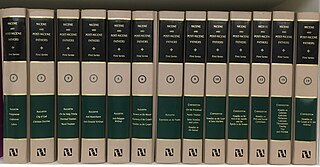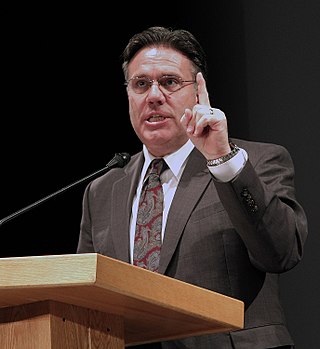
The Book of Mormon is a religious text of the Latter Day Saint movement, which, according to Latter Day Saint theology, contains writings of ancient prophets who lived on the American continent from 600 BC to AD 421 and during an interlude dated by the text to the unspecified time of the Tower of Babel. It was first published in March 1830 by Joseph Smith as The Book of Mormon: An Account Written by the Hand of Mormon upon Plates Taken from the Plates of Nephi. The Book of Mormon is one of the earliest and most well known unique writings of the Latter Day Saint movement. The denominations of the Latter Day Saint movement typically regard the text primarily as scripture and secondarily as a record of God's dealings with ancient inhabitants of the Americas. The majority of Latter Day Saints believe the book to be a record of real-world history, with Latter Day Saint denominations viewing it variously as an inspired record of scripture to the lynchpin or "keystone" of their religion. Some Latter Day Saint academics and apologetic organizations strive to affirm the book as historically authentic through their scholarship and research, but mainstream archaeological, historical, and scientific communities have discovered little to support the existence of the civilizations described therein, and do not consider it to be an actual record of historical events.

Paul, commonly known as Paul the Apostle and Saint Paul, was a Christian apostle who spread the teachings of Jesus in the first-century world. For his contributions towards the New Testament, he is generally regarded as one of the most important figures of the Apostolic Age, and he also founded several Christian communities in Asia Minor and Europe from the mid-40s to the mid-50s AD.

The parable of the Good Samaritan is told by Jesus in the Gospel of Luke. It is about a traveler who is stripped of clothing, beaten, and left half dead alongside the road. First, a Jewish priest and then a Levite come by, but both avoid the man. Finally, a Samaritan happens upon the traveler. Although Samaritans and Jews were generally antagonistic towards each other, the Samaritan helps the injured man. Jesus is described as telling the parable in response to a provocative question from a lawyer, "And who is my neighbor?", in the context of the Great Commandment. The conclusion is that the neighbor figure in the parable is the one who shows mercy to their fellow man.

Jesus, also referred to as Jesus Christ, Jesus of Nazareth, and many other names and titles, was a first-century Jewish preacher and religious leader. He is the central figure of Christianity, the world's largest religion. Most Christians believe Jesus to be the incarnation of God the Son and the awaited messiah, the Christ that is prophesied in the Old Testament.

Nicholas Thomas Wright, known as N. T. Wright or Tom Wright, is an English New Testament scholar, Pauline theologian and Anglican bishop. He was the bishop of Durham from 2003 to 2010. He then became research professor of New Testament and Early Christianity at St Mary's College in the University of St Andrews in Scotland until 2019, when he became a senior research fellow at Wycliffe Hall at the University of Oxford.

Sacred tradition, also called holy tradition or apostolic tradition, is a theological term used in Christian theology. According to this theological position, sacred tradition is the foundation of the doctrinal and spiritual authority of Christianity and of the Bible. Thus, the Bible must be interpreted within the context of sacred tradition and within the community of the denomination. The denominations that ascribe to this position are the Catholic, Eastern Orthodox, and Oriental Orthodox churches, and the Assyrian churches.

Biblical inspiration is the doctrine in Christian theology that the human writers and canonizers of the Bible were led by God with the result that their writings may be designated in some sense the word of God. This belief is traditionally associated with concepts of the biblical infallibility and the internal consistency of the Bible.

The Finding in the Temple, also called Christ among the Doctors or the Disputation, is an episode in the early life of Jesus depicted in chapter 2 of the Gospel of Luke. It is the only event of the later childhood of Jesus mentioned in a canonical gospel.
Joseph Fielding McConkie was a professor of Ancient Scripture at Brigham Young University (BYU) and an author or co-author of over 25 books.
James A. Sanders was an American scholar of the Old Testament/Hebrew Bible and one of the Dead Sea Scrolls editors. Sanders grew up in racially segregated Memphis, attended a Methodist church, and went to Nashville to attend Vanderbilt University where he associated with Baptist & Methodist fellowships. He was the first to translate and edit the Psalm Scroll, which contained a previously unknown psalm. Sanders retired in the late 1990s, but published and lectured regularly into his 90s.
The fate of the unlearned, also known as the destiny of the unevangelized, is an eschatological question about the ultimate destiny of people who have not been exposed to a particular theology or doctrine and thus have no opportunity to embrace it. The question is whether those who never hear of requirements issued through divine revelations will be punished for failure to abide by those requirements.
In Mormonism, revelation is communication from God to man. Latter Day Saints teach that the Latter Day Saint movement began with a revelation from God, which began a process of restoring the gospel of Jesus Christ to the earth. Latter Day Saints also teach that revelation is the foundation of the church established by Jesus Christ and that it remains an essential element of his true church today. Continuous revelation provides individual Latter Day Saints with a "testimony", described by Richard Bushman as "one of the most potent words in the Mormon lexicon".
Jewish deicide is the notion that the Jews as a people are collectively responsible for the killing of Jesus, even through the successive generations following his death. A Biblical justification for the charge of Jewish deicide is derived from Matthew 27:24–25. Some rabbinical authorities, such as 12th-century scholar Maimonides and, more recently, ultranationalist Israeli rabbi, Zvi Yehuda Kook (1891–1982), have asserted that Jesus was indeed stoned and hanged after being sentenced to death in a rabbinical court.
Daniel Hansen Ludlow was a professor of religion at Brigham Young University (BYU) in Provo, Utah. He was also the chief editor of the Encyclopedia of Mormonism, published in 1992 by Macmillan.
Richard Douglas Poll was an American historian, academic, author and member of the Church of Jesus Christ of Latter-day Saints. His liberal religiosity influenced his notable metaphor about "Iron Rod" vs. "Liahona" LDS Church members.
The Religious Studies Center (RSC) is the research and publishing arm of Religious Education at Brigham Young University (BYU), sponsoring scholarship on the culture, history, scripture, and doctrine of the Church of Jesus Christ of Latter-day Saints. The dean of Religious Education serves as the RSC's director, and an associate dean oversees the two branches of the RSC: research and publications.

Christianity in the 1st century covers the formative history of Christianity from the start of the ministry of Jesus to the death of the last of the Twelve Apostles and is thus also known as the Apostolic Age. Early Christianity developed out of the eschatological ministry of Jesus. Subsequent to Jesus' death, his earliest followers formed an apocalyptic messianic Jewish sect during the late Second Temple period of the 1st century. Initially believing that Jesus' resurrection was the start of the end time, their beliefs soon changed in the expected Second Coming of Jesus and the start of God's Kingdom at a later point in time.
The historical reliability of the Gospels is evaluated by experts who have not found a complete consensus. While all four canonical gospels contain some sayings and events which may meet one or more of the five criteria for historical reliability used in biblical studies, the assessment and evaluation of these elements is a matter of ongoing debate. Virtually all scholars of antiquity agree that Jesus of Nazareth existed in 1st century Judea, but scholars differ on the historicity of specific episodes described in the biblical accounts of Jesus, and the only two events subject to "almost universal assent" are that Jesus was baptized by John the Baptist and was crucified by the order of the Roman Prefect Pontius Pilate. There is no scholarly consensus concerning other elements of Jesus's life including the two accounts of the Nativity of Jesus, the miraculous events including the resurrection, and certain details about the crucifixion.
The canon of the New Testament is the set of books many modern Christians regard as divinely inspired and constituting the New Testament of the Christian Bible. For historical Christians, canonicalization was based on whether the material was written by the apostles or their close associates, rather than claims of divine inspiration. However, some biblical scholars with diverse disciplines now reject the claim that any texts of the Bible were written by the earliest apostles.

Bradley Ray Wilcox is a professor of ancient scripture at Brigham Young University (BYU) and has been a counselor in the Young Men general presidency of the Church of Jesus Christ of Latter-day Saints since April 2020.










